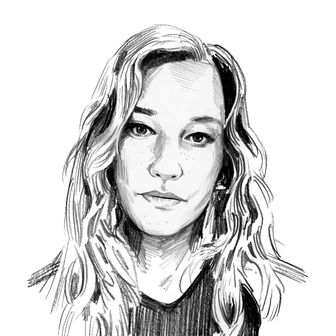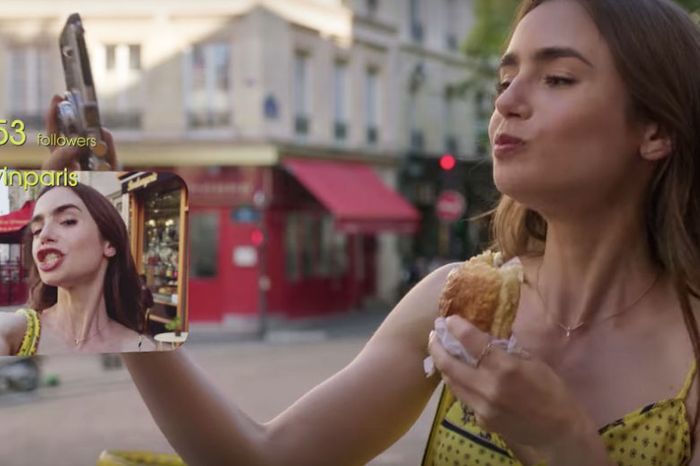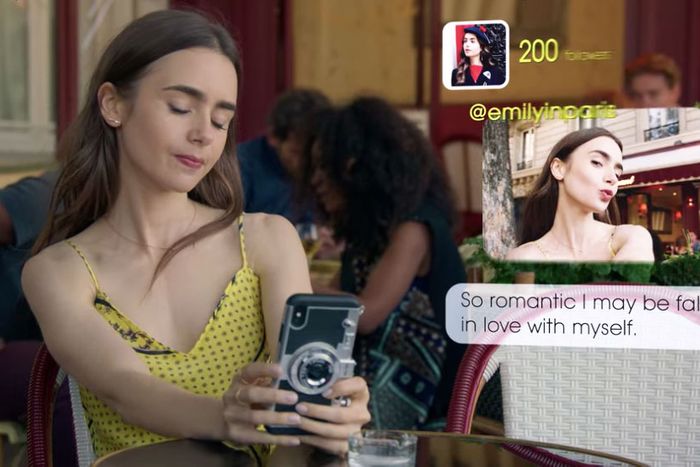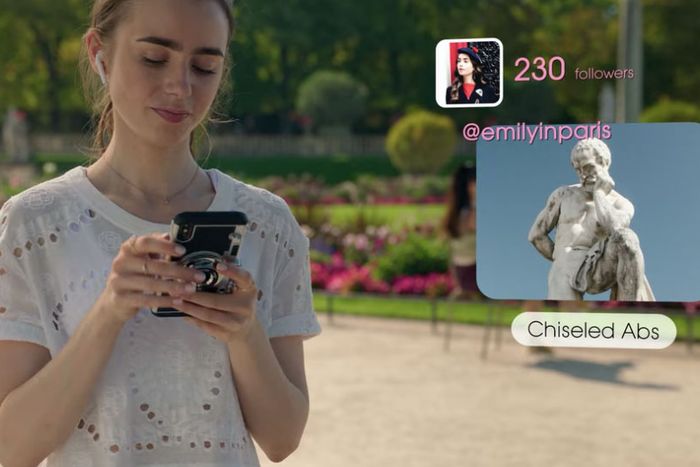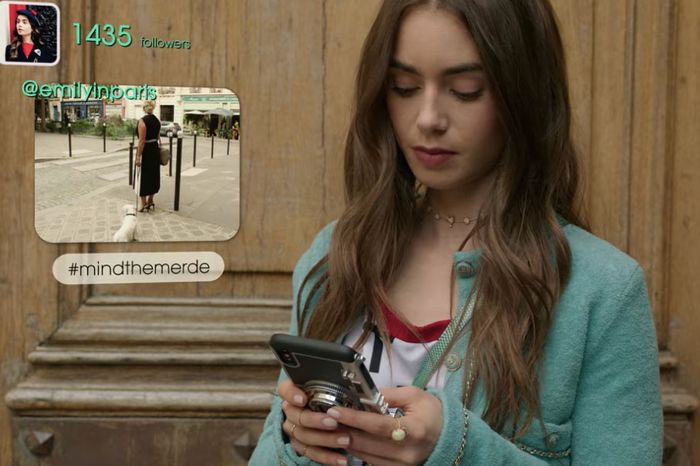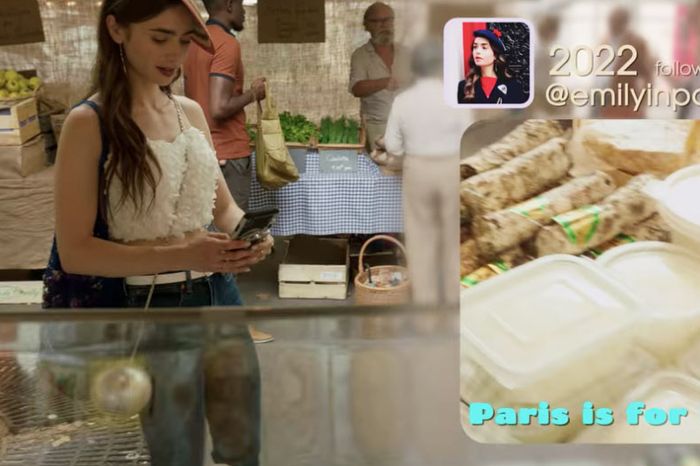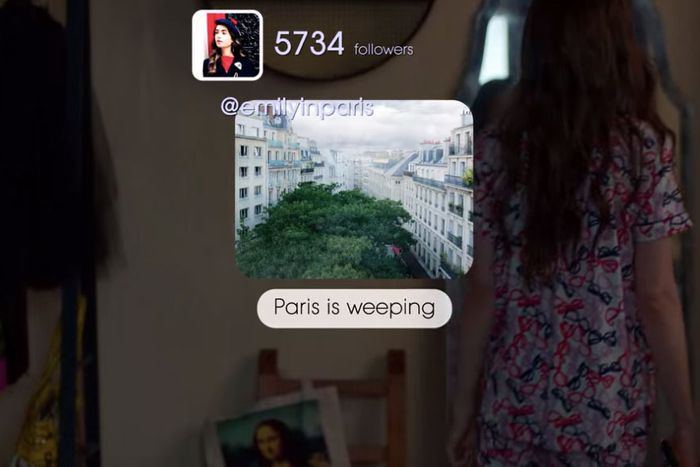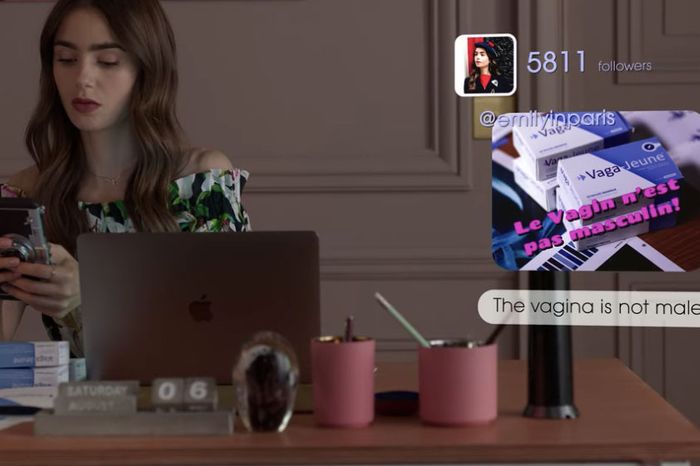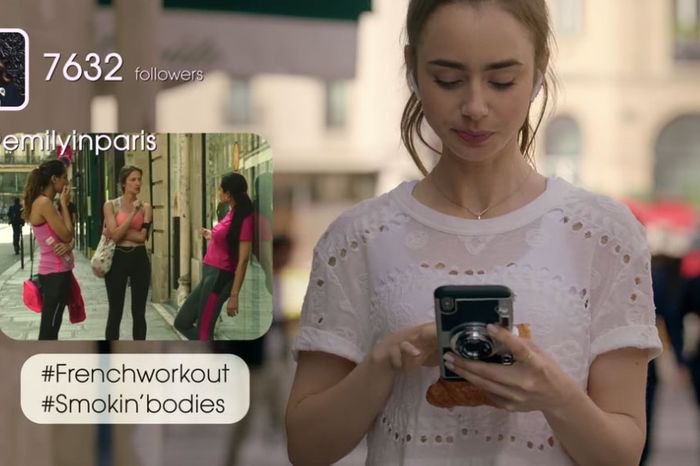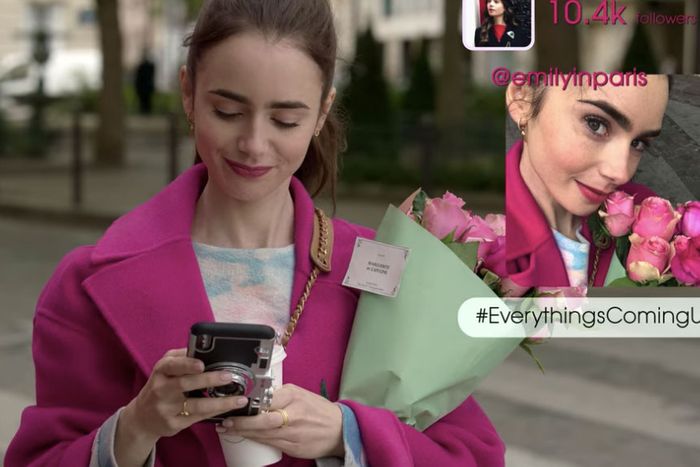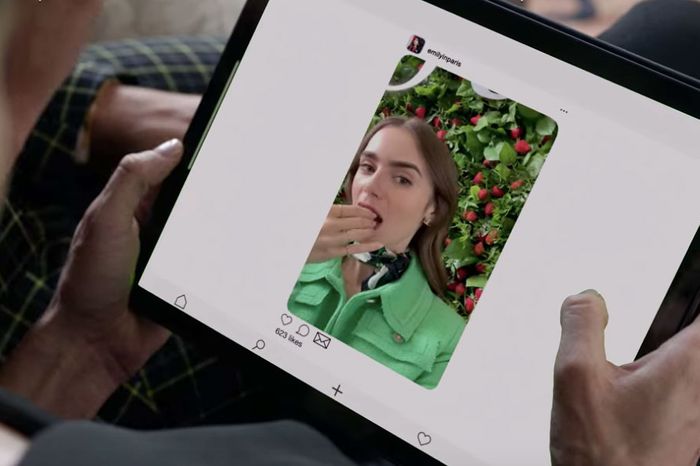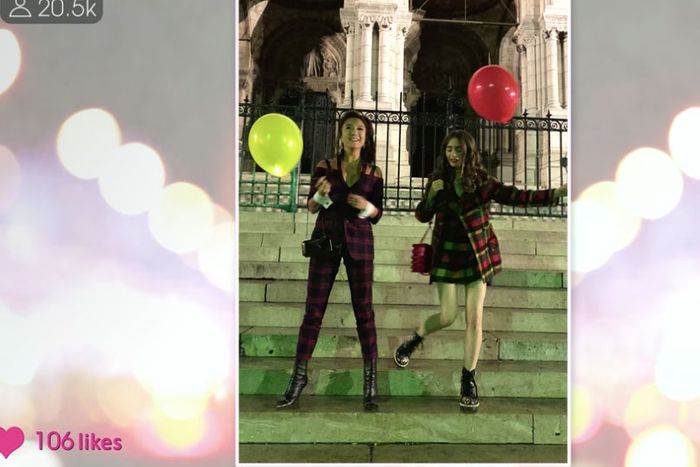
Darren Star has done it yet again: centered an entire show on a thin, gently delusional white woman whimsically exploring a major metropolitan area in wildly expensive couture purchased on a mid-level salary. This time around, the series is Netflix’s Emily in Paris, and our protagonist is Emily Cooper (Lily Collins), a 20-something digital-marketing whiz (one of the more disturbing onscreen career aspirations this side of late-capitalist America) whose job sends her to Paris from Chicago — which is rendered briefly in the first episode as a poorly lit hub of Cubs merch and cloudy glasses of white wine. Emily has been tasked with bringing an “American point of view” to a French marketing agency called Savoir, where everyone instantly hates her because she says things like “To build a brand, you need social-media engagement. It’s not just about the number of followers. It’s about content, trust, interest, and engagement.” Much like Carrie Bradshaw before her, Emily will not be deterred from her biggest dream, which, again, is becoming really good at marketing. Over the course of ten episodes, Emily wins over her coworkers with her inspired social-media campaigns.
The above paragraph may suggest that I hated Emily in Paris. In actuality, I gulped the entire series down in one evening like a bottle of cheap Bordeaux, finding its cheerfully insane, totally smooth surface and hollow core the perfect cure for what currently ails me (being alive right now). I happily accepted that washboard-abs Emily would go running in a delicate white lace crop top before work each morning, emerging totally dry and cramming an entire pain au chocolat into her mouth while dressing herself in a floral two-piece with an identical accompanying puffer coat, then marching into her gorgeous office to come up with viral campaigns for high-end mattresses. I smiled and nodded along as she unconsciously draws the sexual attention of every single man she meets in the first four episodes, including her boss’s married lover. I said, “Okay … fine,” when Emily straight-facedly insults Lou Malnati’s pizza in the series’ first hour.
But there was one part of the show I found difficult to swallow. When we meet Emily, her Instagram handle is her own name, and she has 48 followers; the literal moment she gets to Paris, she swaps her handle to @emilyinparis, begins taking touristy photographs of bouquets of flowers and cheese and cafés and croissants, and, over the course of a few weeks, she becomes enough of an “influencer” to attract the attention of 25,000 strangers and several major brands. It’s not that I don’t buy that, in 2020, a beautiful young white woman could go to Paris and quickly turn into an Instagram star. Nor am I particularly depressed (just normal depressed) by the fact that “becoming an Instagram star” is the new “becoming a renowned writer” for fictional heroines. It’s that Emily’s Instagram feels almost bot-like. It’s populated exclusively with the sort of lowest-common-denominator, basic (or ringarde, as a snooty French designer calls Emily at one point) posts that were perhaps popular at the dawn of Instagram but, when viewed in 2020, seem almost troll-like, as if Emily were secretly engaged in some kind of social-science experiment. On a show where almost nothing makes actual sense but that operates according to a very specific internal Darren Star logic, in which we’ve all become fluent thanks to years of mainlining Sex and the City reruns, Emily’s Instagram is pure Horse_ebooks chaos.
The amount of time I spent thinking about a fake person’s fake Instagram account began to bother me, as it should have, so I did what any sane person living through a multipronged global crisis would do: I cold-DM’d dozens of real-life French Instagram influencers during Paris Fashion Week. I wanted to know: Would Emily’s Instagram actually be as popular as it is on the show, or would it get laughed out of (metaphysical) town? It took me approximately 40 Instagram DMs to get anyone to talk to me, but eventually I convinced Lamia Lagha, Carin Olsson, and Monica de La Villardière
— a German, Swede, and Canadian, respectively, all of whom live in Paris, have been Parisian Instagram fixtures since the app’s early days, and have follower counts ranging from 50,000 to 865,000 — to get on an international phone call during the most Instagrammable time of the year to talk about the Instagram account of a pretend woman on a Netflix show that wasn’t even out yet.
Carin, Monica, and Lamia told me they hadn’t heard much about Emily in Paris until I DM’d them about it, though Carin did say she had heard French people “making jokes” about the show’s likely failure to “show the real Paris” in the same way Gossip Girl had failed to show the “real New York.” Monica said her actually French husband has “no idea what Emily in Paris is,” and none had planned on watching it until I brought it up. “It’s not something that French girls would watch,” says Lamia. Below, these three extremely generous and patient women evaluate several of Emily’s more popular posts to help me get to the bottom of this unprecedented international mystery. In the process, they taught me more about the complex ecosystem of French Instagrammers than I’d ever imagined was possible.
Post 1
Early in the first episode, after walking into her corporate-sponsored apartment, Emily changes her Instagram handle, snaps a selfie out her apartment window, and posts it to her 48 followers with the caption “#roomwithaview.”
“I don’t know what to say,” says Carin, who admits that her own early Instagram posts, circa 2013, were quite similar in nature and, in retrospect, vaguely embarrassing. “You’re talking to someone who posted photos of macarons and the Eiffel Tower, and my Instagram exploded. I was like someone newly in love with someone. But I’m living the life I live today based on what I posted then. I can’t say it’s very original, but at the time, for some reason, people really responded to it. Today, if you post that, it’s boring. But it was exactly what I was doing, so.”
According to Lamia, Parisian women started becoming popular on Instagram about five years ago. “Everyone was talking about the Parisians and the Parisian look and style. And most of the girls were not even Parisian but just living in Paris,” she muses. “I would say this post is classic. A lot of girls would do that when they arrive in a place that’s beautiful. I think it’s okay, even though it’s also a bit cliché.”
“It’s super-basic, but it would do well,” echoes Monica, but with the disclaimer that it wouldn’t impress anyone except Americans. “People in Paris are really tired of this. I’ll use myself as an example. I have a big North American following, but my biggest following is French. So that means I have to be aware of that. If my following were predominantly even just Anglo-Saxon, I would then perhaps be less wary of those [types of posts]. Maybe I would just stick my arm out my window if I didn’t have super-jaded Frenchwomen being like, [feigns smoking], ‘That is such a cliché. Fuck you.’”
Post 2
Emily takes a Boomerang of herself sinking her teeth into a pain au chocolat. She captions it “Butter + chocolat = <3.”
“Uh, I don’t know,” says Lamia. “This is too much for me. I would not do that.”
“If I posted that, let me tell you what would happen,” says Monica. “A lot of North Americans and a few British people would be like, ‘OMG, amazing, you are living your best life.’ Then there would be all the French people who would probably unfollow me, pushed over the edge. Then there would be a few people being like, ‘As if you ate that pain au chocolat.’” By way of example, she explains that she recently posted a photo of a lasagna and lost several followers.
Post 3
Emily takes a selfie outside a café alone. “So romantic I may be falling in love with myself,” she writes. After a melancholy interaction with a coworker, she edits the caption to read, “Lonely in Paris.”
All three women wonder aloud if this is Emily’s version of a thirst trap. Lamia finds it disappointingly cliché. “That’s very Parisian. All the girls sit in cafés, they love to wear red lipstick, they smoke. Even though, for me, a Parisian is not just that girl,” she says. “There’s so much more to it. Some girls played with [this image] too much.”
Monica seems genuinely concerned. “Aww. That is so sad. Does she get likes for it?” she asks. (She does.) But Monica also finds the use of location effective. “If you want to make your life look like this Parisian utopia — which I’ve moved away from a little bit — you just need to sit in the café outside your house,” she adds, laughing. “The picturesqueness of the city just makes everyone look cool. And I have not always forgone the café shot. Sometimes it’s just a great way to show a pair of jeans or whatever. But I’ve always tried to do something a little different, and I think I suffer from it. If I did something more basic, I’d have more followers. You can quote me on that.”
Post 4
Emily snaps a photo of a male statue and writes, “Chiseled abs.”
This one makes Monica laugh for several seconds. “Who made this show?” she asks. When I tell her it’s Darren Star, she screams, “What?! Oh my God, maybe it’s gonna be a really big hit? Shit, that really annoys me.” Once we have gotten over Emily’s certain future ubiquitousness, Monica admits this post is probably Emily’s best so far. “This is the sort of humor I do enjoy and try to bring to my own account. A lot of the time, people don’t totally understand my humor,” she says, “but I think Emily made a funny, and she should keep going in that direction.”
“This is the post?” asks Lamia. “Again, uh … it’s not something that I think a Frenchwoman would post. I can understand she would have a lot of likes because it’s kind of funny. I don’t know. Maybe a French girl could do that? Somewhere else. But not in France. No, no, no.”
Post 5
At this point, Emily’s account has rocketed up to nearly 1,500 followers. She steps in dog shit, takes a photo of the culprit, and writes, “#mindthemerde.”
“Oh, so she’s learning some vocabulary,” remarks Monica. “I think if you put anything that isn’t aesthetically pleasing, like, if you show actual poo … knowing my followers, I would lose a lot of followers. I mean, if I can lose followers for a lasagna—”
“Oh no,” says Lamia. “It’s like when Carrie Bradshaw walks into shit and she’s like, ‘Merde!’ A lot of the time when people use a French word, it’s merde or bonjour. No. This is very cliché.”
Post 6
Visiting a cheese market, Emily snaps a photo of several fromages and writes, “Paris is for lovers,” then edits it to read, “Paris is for cheese lovers.”
“I mean, it is for cheese lovers,” says Monica. “She’s a crowd-pleaser. Emily’s account seems like it’s more of a general Paris lifestyle account. It’s not really a fashion account. So she wouldn’t have the same level of disappointed French fashionistas as I incur. I think she should go with it. So far, the only one I think would be an all-around failure is the poo one.”
“She’s right,” says Lamia. “There is a lot of good cheese in Paris. Connecting these posts together, they are very cliché, but I guess this is the idea.”
Carin goes quiet for a moment. “I’m sure Parisians were super-annoyed with me in the beginning with my Eiffel Tower and my macarons,” she says.
Post 7
It’s raining. A recently dumped Emily takes a photo outside her apartment window (again). “Paris is weeping,” she writes.
Nobody seems very impressed with this one. I take the opportunity to ask Monica who the ne plus ultra Parisian Instagrammer is, and she pauses. “I don’t think I should name names,” she says. “I want to help you, but …” After she gets my assurance that the mention will be positive, she names Jeanne Damas, an early French influencer with 1.5 million followers who’s “really a friend of mine. She has a serious brain. She’s way younger than me. She launched [her brand] Rouje when she was 24. She is the true française who launched 1,000 copycats. A lot of people are trying to get the Jeanne Damas look and vibe, but nobody is Jeanne Damas except Jeanne Damas.”
Post 8
Emily has a great day at work after she posts a photo of the vaginal-rejuvenation brand she’s representing and accompanies it with the caption “The vagina is not male!,” referring to the fact that the French word for vagina takes a male pronoun. Brigitte Macron retweets it; Emily ratchets up to 6,000 followers, and her coworkers ask her to drink with them.
“Dammit!” exclaims Monica. “I’ve been ranting about this for years! Listen, the French pronoun for vagina is male, but the French pronoun for breast is also male. And if you want to say the commonly used slang word for penis, that’s female. I’m gonna be honest, Emily, I wish I had tweeted that years ago. I would have retweeted it.”
“Compared to the things she posted before, it’s kind of extreme. Baguette, merde, cheese, vagina?” says Lamia. “That’s kind of funny.”
Post 9
Outside a French workout class, Emily spies a series of Frenchwomen smoking. “#Frenchworkout. #Smokin’ bodies,” she writes.
“That is very accurate,” says Monica, “but I will say one thing. My Pilates teacher, who is French, would want me to jump in here. I do have French friends who are very slim and elegant and attractive who smoke. But they walk everywhere, and they eat in this really specific way. They don’t deny themselves anything. They all eat bread; they just don’t eat that much of it. But because of Paris becoming more international in the past five or ten years, there are now more modern approaches to Pilates and all that stuff. Now I have as many French friends who are into their workouts as ones that aren’t.” All of that’s to say that Emily “made a very interesting observation with this post,” Monica adds. “I’m starting to want to follow Emily’s Instagram account. She’s a lot wittier than I’d originally pegged her as.”
“It’s true,” says Lamia. “Frenchwomen smoke a lot. And this whole sport thing just started in Paris. So a lot of women started to do sports, but they’re still smoking. I can see how this would be funny.”
Post 10
Emily now has more than 10,000 followers. She posts a photo of a bouquet of pink roses and captions it “#EverythingsComingUpRoses!”
“For me, it’s very limited,” says Lamia.
“Okay, at this point, Emily, I just feel like you can do better than that,” says Monica. “But we all have our off days.”
Post 11
Emily attends an “exclusive influencer lunch” hosted by Durée Cosmetics. She is asked to post about the brand at least five times, is treated poorly by her fellow attendees, and receives a smaller gift bag than influencers with larger followings. But she proves victorious after posting a Boomerang of herself eating a strawberry with the caption, “Durée is smudgeproof, even when you’re berry hungry.” The CEO of Durée soon asks Emily to become a brand ambassador, explaining that influencers have replaced traditional marketing firms. “You could be more successful as an influencer,” she says. “You’re high on Paris, and your followers are falling for that.” Emily, dedicated to her goal of becoming really good at working at a marketing firm, says no.
“That would never happen,” says Lamia, referring to all of it. But she admits that she’s “shy” and avoids these kinds of events: “It takes too much of my energy. It’s a little bit fake sometimes.” Carin, who says she used to attend more of these sorts of lunches before “you realize you can’t really take three hours for lunch every day,” is similarly adamant that she has never experienced that sort of competitive influencing environment. “There’s definitely sometimes a hierarchy in terms of where you’re seated,” she says. “But if the brand is kind enough to provide a goody bag, I don’t think it would be bigger or smaller depending on your following.”
“Oh, that’s a real thing,” counteracts Monica. “There’s levels of gifting. And you notice when other people are getting stuff.” She thinks that, by design, influencers are often “pitted against each other” by the brands. “I don’t know that it’s necessarily a conscious thing by the brands, but the hilarious choice to gift or dress or seat people differently — this is where the brands get to use all of their power. But that’s a whole other TV show.”
All three are unmoved by “berry hungry.”
Post 12
Emily’s boss, Sylvie (Philippine Leroy-Beaulieu) — who, as a reminder, hates her — asks her to delete her Instagram because the firm’s clients are getting mad that Emily is promoting other brands for free. A morose Emily takes one last spin around Paris with her friend Mindy (Ashley Park), taking videos of the two of them drinking Champagne on carousels and running around drunk with balloons. When a mattress client sees one of the stories, she asks Emily to re-create it for one of the brand’s campaigns. “I guess you’re an influencer now,” huffs Sylvie. “But only for our clients.” Emily concludes the first season with more than 25,000 followers.
Carin agrees that the French have traditionally had a harder time than their Western counterparts in embracing digital marketing or social media. “I don’t think that [plot point] is taken out of nothing. There has been a harder time explaining why it’s good and necessary. I can relate to that,” she says. But she doesn’t think the Sylvies of the industry are going anywhere. “I don’t think influencers will ever replace advertising in metros or magazines,” Carin says. “But maybe I’m naïve.”
Lamia is more concerned about the content of Emily’s drunken stories. “Balloons?” she says. “It would be fine to spend a night with her friend in the city and take videos, but balloons? I’m not sure about the balloons.”
The final verdict on Emily’s ’gram:
“She’s trying to find the easiest way to get more and more followers who respond to these kinds of clichés,” says Lamia. “She’s playing that game. And it doesn’t feel [contemporary]. Paris has changed so much.” Monica thinks Emily is funny but would really appeal only to an American audience. “Her friends back home would be loving Emily’s Instagram, but I don’t think she’d cut it. If you’re starting a new Instagram account in 2020, you have to separate yourself. I don’t see her shooting into notoriety for this account.”
But, Monica adds, “I’d give her the advice not to worry about it too much. I think we should all live as if Instagram could spontaneously combust any day.”


